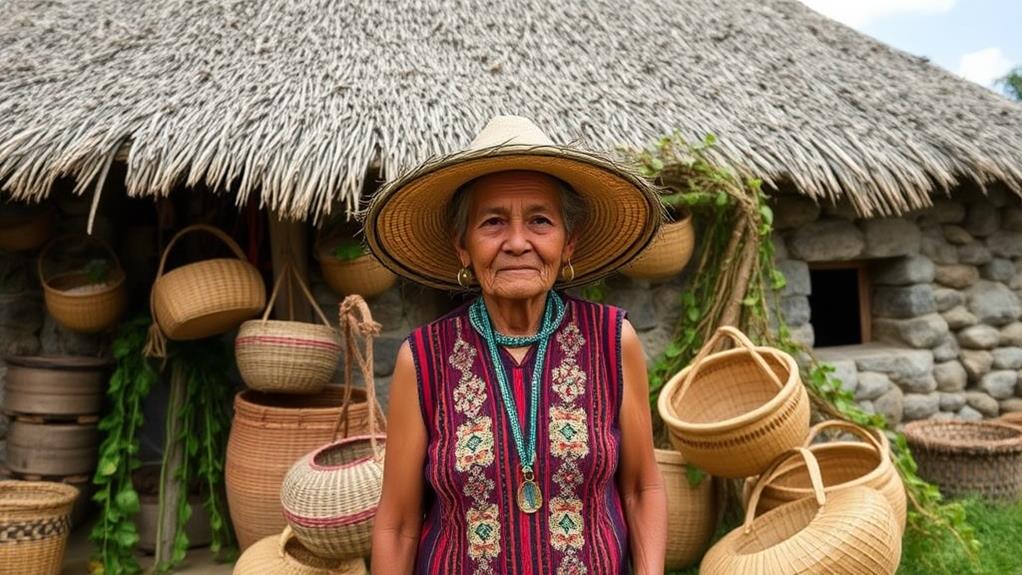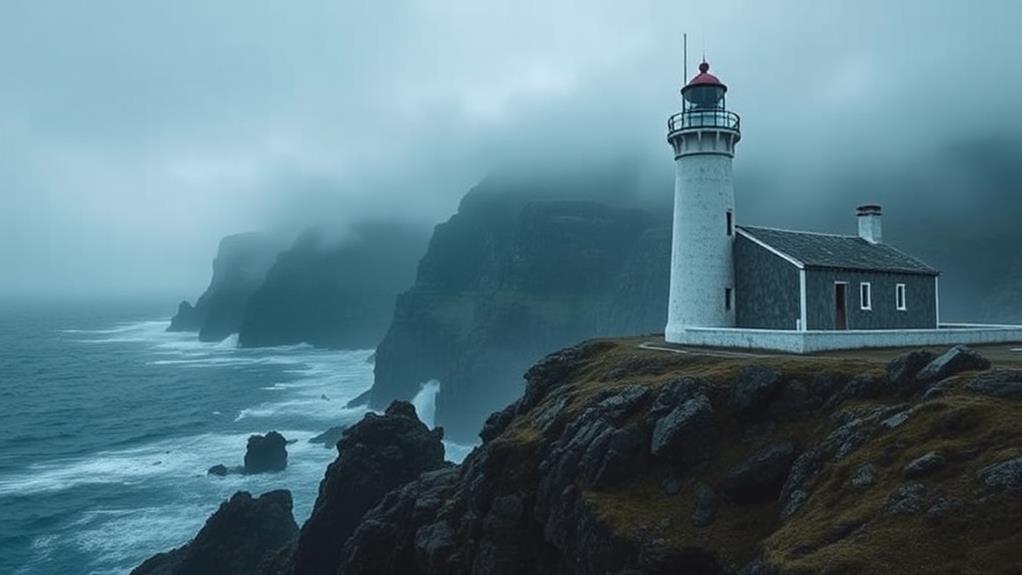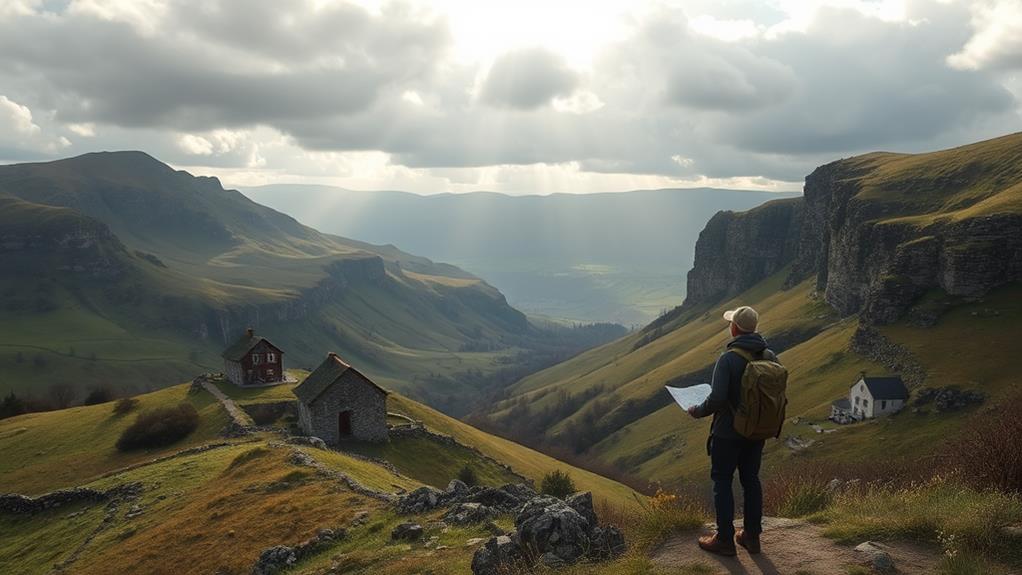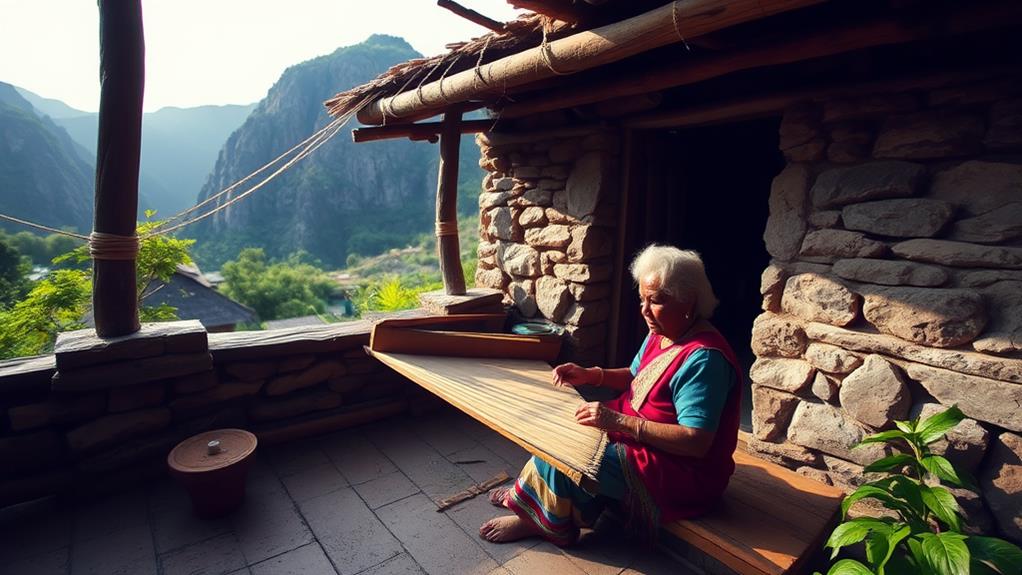Batanes' Unique Culture Emerges from Its Rugged Landscapes
Batanes' dramatic topography and climate have shaped a distinct cultural identity.
The Ivatan people have adapted to this unforgiving environment, resulting in resilient traditions and centuries-old stone houses.
Their strong maritime history is influenced by their island location.
Panoramic Views and Geological Wonders Abound
From the scenic views of Racuh a Payaman, also known as Marlboro Country, to the geological wonders of Mount Karoboban, the island's rugged landscapes are a testament to its unique character.
The island's harsh climate has led to the development of traditional stone houses, which have withstood typhoons and strong winds for centuries.
Exploring Batanes Reveals Hidden Secrets
As you venture into these northernmost islands, you'll discover a rich heritage shaped by the island's unique environment and the Ivatan people's resourcefulness.
There's more to uncover in Batanes, and its secrets await your discovery.
Uncharted Landscapes of Batanes

Batanes' Unique Landscapes
The rugged terrain of Batanes is characterized by dramatic landscapes shaped by the islands' volcanic origin. Valugan Boulder Beach, with its cliffs and smooth boulders, is a prime example of natural erosion processes that have sculpted this landscape.
Panoramic Views and Rugged Terrains
Batanes offers breathtaking panoramic views, with Marlboro Country's rolling hills and vistas being a hiker's paradise.
The rugged terrains, covering approximately 80% of the province's landscape, showcase the island's untamed natural beauty.
Traditional Ivatan Stone Houses
The traditional Ivatan stone houses, built to withstand frequent typhoons, reflect the cultural heritage of the locals.
These houses demonstrate the islanders' resourcefulness and resilience, with a unique architectural style shaped by harsh environmental conditions.
Blending Natural Beauty and Cultural Heritage
Batanes seamlessly blends natural beauty and cultural heritage, offering an unforgettable experience.
The island's uncharted landscapes, shaped by its volcanic origin and harsh environment, have created a unique cultural identity that's worth exploring.
Climate and Geography Overview
Batanes' Unique Climate and Geography
Batanes, the northernmost province of the Philippines, consists of 10 islands, with only four inhabited, featuring rugged, hilly, and mountainous terrain.
The tropical climate, classified as Köppen Am, brings an average yearly temperature of 26.0 °C (78.8 °F).
The unique geological formations, characterized by dark-grey rock formations and rolling hills, are a result of Batanes' volcanic origin. This stunning natural landscape is a testament to the island's dramatic history.
Typhoons Shape the Islands
Batanes experiences typhoons from July to December, showcasing the raw power of nature.
Volcanic Landscapes
The island's rugged terrain is characterized by dramatic, dark-grey rock formations.
Ideal for Sweet Potatoes
The region's windswept environment makes it an ideal place for growing sweet potatoes, a staple crop in Batanes.
Unspoiled Beauty
Batanes is home to untouched, natural landscapes that remain largely unexplored, waiting for discovery.
Ivatan Culture and Traditions

The Ivatan people's culture is shaped by their environment and characterized by resilience and adaptability to harsh weather conditions. Their traditional way of life is deeply rooted in community collaboration, evident in local festivals like Vatang and Panglagangan, which celebrate their agricultural heritage. These festivals showcase the community's strong bond and cooperation in the face of adversity.
Ivatan oral traditions are rich and convey historical narratives and cultural values. Legends known as kabbata and folk songs (lagi) are passed down through generations, blending indigenous and Spanish elements. These stories reflect the complex history of the region and provide insight into the Ivatans' values and beliefs.
The Ivatan cuisine is simple, healthy, and closely tied to local resources. Staple dishes like salted fish (bagun a yuyunu) and steamed gabi leaves (chinavules) are made from ingredients readily available in the region. These dishes demonstrate the Ivatans' resourcefulness and ability to thrive in a challenging environment.
The Ivatan people's traditional way of life is a testament to their resourcefulness and resilience. Their culture is a unique and fascinating aspect of Batanes, shaped by their history, environment, and community values.
Unique Stone House Architecture
In the rugged landscape of Batanes, traditional stone houses stand as a testament to the Ivatan people's ingenuity and resourcefulness. These sturdy structures have withstood the region's harsh weather conditions, including typhoons, for generations.
Resilience is a hallmark of these stone houses, which have been weathering storms for centuries. The houses' thick cobble and mortar walls, measuring 80 cm to 1 meter, are designed to keep inhabitants safe and dry.
The maintenance of these houses is a testament to the community spirit of the Ivatan people. When roofs need to be replaced, the community comes together to do so, demonstrating their collective spirit.
The use of sustainable design is another notable feature of these stone houses. Locally sourced materials such as coral, limestone, and wood are used, blending seamlessly with the island's natural environment.
This approach to architecture ensures a harmonious relationship between the built environment and the surrounding landscape.
The unique design and historical significance of these houses have made them a cultural icon. They're an integral part of Ivatan cultural heritage, showcasing the people's deep connection with the land and their heritage.
Lighthouses and Maritime History

Batanes' Lighthouses: Beacons of Maritime History
Perched on rugged coastlines, the iconic lighthouses of Batanes stand sentinel, guiding mariners through the treacherous waters between the Philippines and Taiwan. These structures are more than just beacons of light – they're testaments to the resilient Ivatan people and their rich maritime history.
The Basco Lighthouse, built in 1908, towers at 66 feet tall, offering breathtaking views of the surrounding landscapes and ocean.
Smaller, historic lighthouses in Mahatao and Sabtang played a crucial role in guiding ships during the era of Spanish colonization. These lighthouses not only served as navigational aids but also embody the cultural identity of the Ivatan community as seafarers.
The significance of Batanes' lighthouses lies in their importance of maritime navigation and their role in the province's history. As you marvel at these structures, you'll appreciate the importance of maritime navigation and the significance of Batanes' lighthouses in the province's history.
Exploring Batan, Sabtang, and Itbayat
Exploring Batan, Sabtang, and Itbayat
Batan, Sabtang, and Itbayat, the three main islands of Batanes, offer a unique experience shaped by rugged geography and the distinct Ivatan culture. Each island has its own charm, showcasing the islands' stunning landscapes and traditional stone houses.
Batan Island
Batan Island is home to the Basco Lighthouse and Valugan Boulder Beach, which showcase the island's stunning coastal beauty and traditional stone houses made from coral and limestone.
Unforgettable Experiences
Wander through Chavayan village on Sabtang Island, famous for its picturesque stone houses and pristine beaches with unique rock formations.
Scale Mount Karoboban on Itbayat, the northernmost inhabited island, and marvel at its stunning geological features.
Explore Basco's vibrant community spirit, where you can engage with the friendly Ivatan community and experience their unique culture and lifestyle.
Relish the secluded charm of Itbayat, a remote destination that only 25% of Batanes tourists get to experience.
Exploring the Islands
Local transportation options like tricycles and motorbikes for hire make it easy to explore the islands' scenic landscapes and cultural landmarks, immersing yourself in the unique Ivatan culture.
Practical Tips for Travelers

When traveling to Batanes, it's essential to be prepared for the unique challenges that come with visiting this tropical paradise.
Pack layers, as the temperature can range from 10°C to 25°C. The best time to visit Batanes is during the dry season from March to May, when clear skies and mild temperatures create ideal travel conditions.
To get around the islands, rent bikes or tricycles, which cost around PHP 1,000 per day for a motorbike. This is the best way to explore the rugged landscapes and stone houses.
Bring sufficient cash, as many businesses on the island are cash-only. You'll need PHP 100 for registration and PHP 350 for environmental preservation.
Respect local customs by engaging positively with the friendly Ivatan community. This will ensure a more enjoyable and enriching experience for both you and the locals.
Pack waterproof gear, as Batanes has a tropical climate and you'll want to be prepared for any unexpected rain showers.
Local Delicacies and Festivals
Batanes' local cuisine showcases the Ivatan people's connection to the land and sea. Fresh seafood and agricultural products are the stars of local delicacies like uvod (sea urchins), vunes (sweet potatoes), and grilled fish.
Ivatan traditional cuisine emphasizes healthy dishes, such as salted fish (bagun a yuyunu) and steamed gabi leaves (chinavules), reflecting the community's connection to the land and sea.
The region celebrates its cultural heritage through various festivals and culinary traditions:
Festivals and Traditions
Vatang Festival honors the agricultural heritage of the Ivatan people with traditional music, dance, and local food.
Panglagangan Festival highlights the cultural and historical significance of Batanes through local crafts, games, and culinary traditions.
Indigenous Recipes promote authentic Ivatan culture by preserving traditional recipes and showcasing local ingredients.
Traditional Music and Dance immerse visitors in the vibrant cultural heritage of Batanes through lively performances and celebrations.
What Makes the Rugged Landscapes of Batanes Unique Compared to the Islands in The Hundred Islands National park?
The rugged landscapes of Batanes are unique compared to the islands in the Hundred Islands National Park. While exploring the hundred islands offers beautiful limestone formations and clear waters, Batanes boasts dramatic cliffs, rolling hills, and lush greenery. The untamed beauty of Batanes sets it apart from other island destinations.
Cultural Immersion Experiences

Immerse in Ivatan Culture
In Sabtang Village, you'll find traditional stone houses that blend into the rugged landscape.
The village is centered around fishing and farming, which are essential to daily life. You can participate in these practices to gain a deeper understanding of the community's way of life.
Experience Ivatan Festivals
The Vatang and Panglagangan Festivals celebrate the community's agricultural heritage and local traditions.
These festivals showcase Ivatan oral traditions, legends, and folk songs, which are vital to their cultural identity.
Learn from Locals
Through homestays and guided tours, you'll have the opportunity to learn from locals about their customs and traditions.
By staying with local families, you'll appreciate their traditional practices and way of life.
Frequently Asked Questions
What Are the Unique Culture of Batanes?
Batanes' culture is deeply rooted in tradition. This is evident in the communal farming practices, where locals work together to till the land, demonstrating the strong sense of community and cooperation.
Hospitality is a significant aspect of Ivatan culture. When visiting traditional stone houses, you'll be warmly welcomed and treated to local cuisine, such as salted fish and steamed gabi leaves, which showcases the islanders' generosity and kindness.
The island's heritage is celebrated through various cultural festivals. Two notable examples are Vatang and Panglagangan, which highlight the island's rich history and cultural traditions.
Historical landmarks, folk music, and traditional crafts also reflect the community's history and character. For instance, the intricate weaving techniques and traditional crafts, such as woodcarving and pottery, are distinct to the island and reflect its unique cultural identity.
What Is the Landscape of Batanes?
Batanes' landscape is characterized by rolling hills, dramatic cliffs, and lush pastures. These hills create stunning vistas, while the cliffs plunge into rocky coastlines. The pastures stretch as far as the eye can see, dotted with traditional farms that showcase vibrant sunsets that paint the sky with hues of gold.
The region's coastal waters are gentle and serene. They lap against the shore, while natural reserves protect the unique flora and fauna of the area.
These natural reserves are essential for preserving the region's biodiversity.
Every view in Batanes is a unique and breathtaking sight. The combination of hills, cliffs, pastures, and coastal waters creates a visually stunning landscape that's waiting to be discovered.
What Is the Northernmost Island of Batanes?
Itbayat is the northernmost island of Batanes. Located at the northernmost tip of the Philippines, Itbayat is the largest island in Batanes, known for its rugged terrain and unique geological features like Mount Karoboban.
This island is less frequented by tourists compared to Sabtang Island, but it offers a rich cultural experience. Ivatan culture is showcased through traditional weaving, stone houses, and fishing practices.
Visitors can immerse themselves in local festivals, savor Batanes cuisine, explore historical sites, and learn about farming techniques that have been passed down through generations.
What Is Batanes Best Known For?
Batanes is best known for its stunning rugged landscapes, which attract many visitors. However, the island offers more than just its natural beauty. Batanes also boasts a rich cultural heritage, with its unique Ivatan language and traditional stone houses. The untouched natural beauty of the island is complemented by the warmth and hospitality of its people, making it a truly memorable destination for travelers seeking a deeper connection with both nature and local culture. Visitors can immerse themselves in the charm of Batanes by exploring its historic sites, indulging in local cuisine, and engaging with the friendly locals.
Unique cultural heritage is another aspect that sets Batanes apart. Traditional Ivatan houses, designed to withstand harsh weather conditions, are a testament to the island's rich cultural history.
Batanes is also famous for its local festivals, which showcase the island's distinct culture.
The island's cuisine is another highlight, with dishes that reflect the local way of life. Additionally, fishermen at work provide a glimpse into the island's traditional livelihood.
Traditional attire, storytelling traditions, and island transportation are also an integral part of the Batanes experience.
Community gatherings demonstrate the strong sense of community that prevails on the island, making for an unforgettable experience.